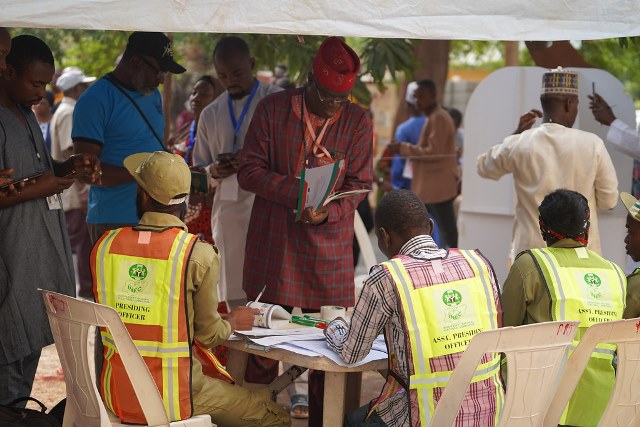[This is an excerpt from an article in The Round Table: The Commonwealth Journal of Intgernational Affairs.]
Limitations of digital technologies in elections
Although technology plays a vital role in strengthening the transparency and credibility of electoral processes, it also has observable limitations that negatively impact democracy. Some limitations of digital technologies are discussed below.
Biometric technology confirms identity, not eligibility
Every technology is designed to accomplish a specific goal, and same applies to digital election technologies. Biometrics involves the measurement and analysis of unique physical or behavioural characteristics, especially for purposes of verifying and identifying an individual (Wolf et al., Citation2017). According to Wolf et al., a biometric voter register can be used to prevent identity theft and multiple voting as it helps to confirm the identity of voters. The authors, however, argue that while biometrics can be used to verify the identity of voters, they cannot be used to verify their eligibility. For example, it cannot be used to determine whether a registrant is underage, is a citizen or is eligible to vote in a certain constituency. In other words, biometric technology alone does not guarantee comprehensive or inclusive voter registration (Wolf et al., Citation2017). This limitation presents a problem not only to credible electoral process but also to democracy. This is particularly bad for Nigeria which lacks a comprehensive reliable register of citizens. One manifest implication of this limitation is the underage voting common in some states in the north highlighted earlier.
Technology does not prevent human manipulations and mistakes
Electoral technologies are operated by human beings with varying skills, competences and interests. As a consequence, some mistakes might occur due to human errors, while others might be deliberately engineered to favour a particular party or candidate. Wolf et al. (Citation2017) asserted that biometric technology can prevent some types of electoral fraud, but it cannot prevent human manipulations and mistakes. The authors observe that in a context where electoral fraud is common, new kinds of manipulation may occur. This typically described INEC’s conduct in the just concluded 2023 general elections, where the electoral umpire failed to upload pooling unit results of the presidential election on IReV portal, blaming technical glitches. Contrary to INEC’s excuses, some observers believed that the electoral body deliberately withheld uploading presidential election results on IReV to achieve a predetermined outcome (Premium Times, April 4, Citation2023), that is, to favour the candidate of the ruling party. These views are not misplaced considering that INEC was able to upload National Assembly election results conducted the same day as the presidential election. For technology efficiency in elections, EMBs must put mechanisms in place to guard against human manipulations. In addition, Suleiman et al. (Citation2021, p. 10) recommend that INEC should develop relevant training modules for its staff on the appropriate use of technologies in order to reduce some of the human errors encountered during elections.
Technology does not prevent or resolve political or social crises
The International Institute for Democracy and Electoral Assistance (International IDEA) (Citation2018) observes that technology has been introduced in some countries with inadequate research, planning, testing, training or voter education, resulting in decreased trust in the process and increased costs to the electoral budget. As a consequence, many EMBs face the challenge of maintaining and replacing software and hardware, which has raised concerns about the sustainability of some electoral technology (International IDEA, Citation2018). It has also been observed that in many cases, technology does not necessarily improve trust in the process or address the problem it sought to resolve. Hence, the International IDEA (Citation2018) states, ‘technology is not necessarily the best solution or an end in itself. It can neither prevent nor resolve political or social crises’ (p. 19).
Technological breakdown and failures
There is an erroneous assumption that digital technologies always work correctly and without failure. Cheeseman et al. (Citation2018, p. 1405) called this assumption ‘digital fallacy 1’, arguing that the impression that technology works with 100% accuracy is not always the case as things can and often do go wrong. Elucidating this point, the Elections Observation Group (ELOG) in the (Citation2013) Kenya elections reported that the electronic voter identification kits failed at some point during the election in over half of the country’s polling stations (Elections Observation Group [ELOG], Citation2013), compelling polling staff to revert to manual registers. In a related development, Barkan (Citation2013) stated that the electronic result transmission system failed more comprehensively. He explains that early result transmissions recorded a remarkably high number of rejected ballots; after examination, it was announced that the system had arbitrarily multiplied the number of rejected ballots by eight. This depicts a typical case of system failure.
Nigeria and the flawed 2023 elections
Nigeria’s 2019 general elections – a shattered hope?
The Commonwealth on Nigerian elections: “Can do better”
Limited internet access & inclusion
One concern about the use of technology in elections relates to limited internet access and inclusion. Emerging evidence suggests that politically marginalised groups (especially on the basis of ethnicity) tend to have significantly lower internet penetration rates than others that enjoy greater standing, as a result of continual political bias in the allocation of internet coverage (Ibeanu, Citation2019). Ibeanu further states that ICTs tend to reinforce the socio-cultural, economic and gendered environments in which they are embedded, which can entrench discrimination and social exclusion rather than increase accountability to the broader public. Another related concern refers to the problem of digital divide. Electronic voting can enfranchise the ‘haves’ and make it easier for them to vote but not help the ‘have nots’ (Hall, Citation2015). Similarly, it can discourage or exclude illiterate voters (especially in rural communities) from the electoral process.
Conclusion
From the foregoing discussion, it is clear that digital technologies have considerably improved election management processes in Nigeria. The use of Electronic Voters Register, Automatic Fingerprints identification System, Smart Card Reader and BVAS has reduced the incidence of multiple registrations and multiple voting to the barest minimum, while the introduction of e-collation support platform and IReV has demonstrated that electoral processes can be made more transparent and credible. In this regard, the incorporation of ICTs in election management in Nigeria has curbed excessive electoral fraud to the barest minimum and improved the quality of elections.
However, in spite of these achievements, the democratising effects of technology remain restricted. Apart from participation, the principles of equality and representation have not been entrenched.
Chris Onyekwelu is Head of Research and Training, Institute of Economic Research of Africa (IERA), Dreamville College, Gaborone, Botswana.






